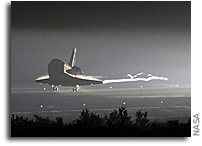On June 1, 2011, NASA’s Space Shuttle Endeavour completed its final mission, marking an iconic moment in the annals of human space exploration. As the spacecraft gracefully descended through Earth’s atmosphere, one couldn’t help but ponder: what does the return of a space shuttle really signify for the future of space travel? This question encapsulates both nostalgia and the anticipation of what lies ahead in our relentless quest for discovery.
Endeavour, having spent 19 years in service, was the youngest of NASA’s shuttle fleet and a testament to human ingenuity and perseverance. Its final mission, STS-134, was not merely a journey into orbit; it was a spirit-laden endeavor. With an array of scientific instruments onboard, it delivered the Italian Space Agency’s Alpha Magnetic Spectrometer, a state-of-the-art particle physics experiment, to the International Space Station. This mission represented a cumulative effort across nations, reinforcing the notion that humanity’s thirst for knowledge transcends borders.
However, Endeavour’s return to Earth also posed a conundrum. As the shuttle glided towards its landing site at the Kennedy Space Center in Florida, one was left wondering: how does the conclusion of this era influence future space missions? The Space Shuttle program heralded a golden age of technological advancements and international collaboration. But with its retirement, the aerospace community now faces challenges in ensuring continued innovation and exploration capabilities.
The potential for the burgeoning commercial space industry to fill the void left by the shuttle program presents a double-edged sword. On one hand, private entities are igniting a revolution, offering opportunities for scientific research and enhanced accessibility to space. On the other, there lies the undeniable risk that commercialization could compromise the core scientific missions that have historically defined space exploration.
As Endeavour touched down in a plume of dust, a sense of finality enveloped the world. Yet, it also paved the way for emerging technologies and strategies to revolutionize our ventures beyond Earth’s atmosphere. It is essential to consider: are we prepared to embrace the challenges of private enterprise in space exploration, or will we yearn for the stability that government-funded programs provided?
In its wake, Endeavour left more than just memories; it stirred a contemplative dialogue about the path forward. With the doors to interstellar possibilities wide open, we stand at a precipice—ready to grasp the opportunities that lie ahead, even as we honor the legacy of a spacecraft that helped elevate humanity’s aspirations toward the stars.
